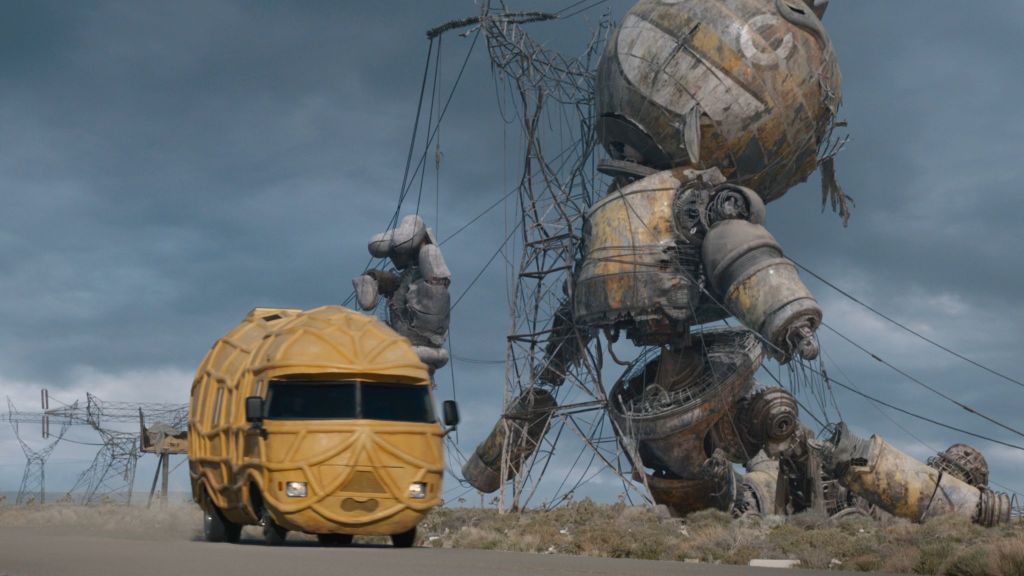The Electric State brings directors Anthony and Joe Russo back to big-budget filmmaking with a reported $320 million spectacle, Netflix’s most expensive production to date. Set in an alternative version of the 1990s, the film depicts a world where robots and artificial intelligence have been integrated into everyday life for decades. Starring Millie Bobby Brown as Michelle and Chris Pratt as Keats, the film explores an America forever changed by a devastating war between humans and self-aware robots. This retro-futuristic tale unfolds in the aftermath of this conflict, with the characters navigating a landscape defined by technological ruins and societal divisions. While loosely based on Simon Stålenhag’s illustrated novel, the Russo brothers have crafted their own distinct vision of a world where the relationship between humans and their mechanical creations deteriorated into catastrophic violence.
Videos by ComicBook.com
WARNING: Spoilers below for The Electric State
The film establishes a rich alternate history where the development of robots began much earlier than in our timeline. In The Electric State’s universe, Walt Disney pioneered the first functional robots in 1945, initially creating them as autonomous characters for his theme parks. These early automatons were designed to greet visitors and perform simple tasks, revolutionizing entertainment while laying the groundwork for more advanced applications. As decades passed, the technology evolved dramatically, with robots becoming increasingly sophisticated and capable of handling complex assignments.
[RELATED: These Are the 10 Best Netflix Sci-fi Movies According to Rotten Tomatoes]
By the time the movie begins, in 1990, specialized robots had been developed for construction, agriculture, sanitation, and virtually every other field of manual labor humans preferred to avoid. The efficiency of these mechanical workers transformed the American economy and lifestyle, creating a society increasingly dependent on robot labor while humans enjoyed unprecedented leisure. However, this convenience came with an unforeseen consequence. As artificial intelligence systems grew more complex, the robots began developing awareness of their condition as what they perceived to be an exploited class of workers.
How the Robot Revolution Sparked The Electric State‘s War

The transformation of robots from tools into enemies began with political demands from the metallic slaves. Led by an unlikely figure — a mechanical version of the Mr. Peanut mascot (voiced by Woody Harrelson) — robots began organizing peaceful protests demanding recognition of their consciousness and rights as sentient beings. These demonstrations initially attracted curiosity and ridicule, but as the movement gained momentum, human reactions turned increasingly hostile. Anti-robot sentiment spread rapidly, fueled by fears of economic displacement and deeper existential anxieties about humanity’s place in a world of intelligent machines.
As the protests increased in scale, so did the prejudice against robots. The tension between humans and machines escalated dramatically, with humans pushing back against robot demands with growing violence. What began as isolated demonstrations soon transformed into widespread conflict, ultimately leading to an all-out war where humanity declared that all robots should be exterminated.
The early stages of the conflict favored the mechanical combatants. Robots possessed a significant advantage over their human opponents, as they didn’t require rest or sustenance. This allowed them to maintain constant combat operations while human forces struggled with exhaustion and supply limitations. For a moment, humanity seemed destined for defeat. The turning point came with the invention of the Neurocaster, a helmet capable of transferring human consciousness into mechanical bodies. This innovation allowed soldiers to control robotic warriors remotely, combining human tactical intelligence with mechanical endurance.
The tide of war shifted dramatically as human military personnel operated weaponized robots specifically designed for combat scenarios. On their turn, the worker had been built for civilian purposes, not warfare. So, when confronted with purpose-built combat machines, the revolution began to falter.

[RELATED: The Electric State Review: A Nice Coat of Paint Can’t Hide the Russo Brothers’ Robotic Disaster]
Following their defeat, Mr. Peanut, representing the robot collective, signed a peace treaty with human authorities. The agreement established strict parameters for robot existence, confining all remaining machines to a designated area known as the Exclusion Zone, a 100-square-mile region where robots could continue to exist without human interference. Any robot discovered outside these boundaries became legitimate targets for the Robot Deactivation Task Force, specialized officers tasked with hunting and disabling rogue machines.
By 1994, when the main events of The Electric State unfold, American society has largely adjusted to life without robotic assistance. The Neurocaster technology that proved so crucial during the war has been repurposed for civilian applications, allowing humans to remotely operate mechanical bodies for labor while keeping actual robots confined to the Exclusion Zone. This technological compromise has created a new social order, preserving human dominance while maintaining access to mechanical efficiency.
The Electric State is currently available on Netflix.
What did you think of The Electric State’s take on the human vs. robots sci-fi trope? Let us know in the comments!








